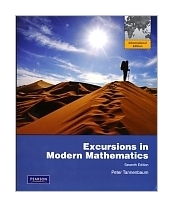|
||
• wydawnictwa polskie
• Zamów informacje o nowościach z wybranego tematu • kontakt
• Cookies na stronie |
EXCURSIONS IN MODERN MATHEMATICS INTERNATIONAL EDITIONTANNENBAUM P.wydawnictwo: PEARSON ED , rok wydania 2010, wydanie VIIcena netto: net price + 5% vat. Excursions in Modern Mathematics, Seventh Edition, shows readers that math is a lively, interesting, useful, and surprisingly rich subject. With a new chapter on financial math and an improved supplements package, this book helps students appreciate that math is more than just a set of classroom theories: math can enrich the life of any one who appreciates and knows how to use Table of Contents
Part 1. The Mathematics of Social Choice 1. The Mathematics of Voting: The Paradox of Democracy 1.1 Preference Ballots and Preference Schedules 1.2 The Plurality Method 1.3 The Borda Count Method 1.4 The Plurality-with-Elimination Method (Instant Runoff Voting) 1.5 The Method of Piecewise Comparisons 1.6 Rankings Profile: Kenneth J. Arrow Key Concepts Exercises Projects and Papers References and Further Readings 2. The Mathematics of Power: Weighted Voting 2.1 An Introduction to Weighted Voting 2.2 The Banzhaf Power Index 2.3 Applications of the Banzhaf Power Index 2.4 The Shapely-Shubik Power Index 2.5 Applications of the Shapely-Shubik Power Index Profile: Lloyd S. Shapely Key Concepts Exercises Projects and Papers References and Further Readings 3. The Mathematics of Sharing: Fair-Division Games 3.1 Fair-Division Games 3.2 Two Players: The Divider-Chooser Method 3.3 The Lone-Divider Method 3.4 The Lone-Chooser Method 3.5 The Last-Diminisher Method 3.6 The Method of Sealed Bids 3.7 The Method of Markers Profile: Hugo Steinhaus Key Concepts Exercises Projects and Papers References and Further Readings 4. The Mathematics of Apportionment: Making the Rounds 4.1 Apportionment Problems 4.2 Hamilton's Method and the Quota Rule 4.3 The Alabama and Other Paradoxes 4.4 Jefferson's Method 4.5 Adams's Method 4.6 Webster's Method Historical Note: A Brief History of Apportionment in the United States Key Concepts Exercises Projects and Papers References and Further Readings Mini-Excursion 1: Apportionment Today Part 2. Management Science 5. The Mathematics of Getting Around: Euler Paths and Circuits 5.1 Euler Circuit Problems 5.2 What is a Graph? 5.3 Graph Concepts and Terminology 5.4 Graph Models 5.5 Euler's Theorems 5.6 Fleury's Algorithm 5.7 Eulerizing Graphs Profile: Leonard Euler Key Concepts Exercises Projects and Papers References and Further Readings 6. The Mathematics of Touring: The Traveling Salesman Problem 6.1 Hamilton Circuits and Hamilton Paths 6.2 Complete Graphs 6.3 Traveling Salesman Problems 6.4 Simple Strategies for Solving TSPs 6.5 The Brute-Force and Nearest-Neighbor Algorithms 6.6 Approximate Algorithms 6.7 The Repetitive Nearest-Neighbor Algorithm 6.8 The Cheapest Link Algorithm Profile: Sir William Rowan Hamilton Key Concepts Exercises Projects and Papers References and Further Readings 7. The Mathematics of Networks: The Cost of Being Connected 7.1 Trees 7.2 Spanning Trees 7.3 Kruskal's Algorithm 7.4 The Shortest Network Connecting Three Points 7.5 Shortest Networks for Four or More Points Profile: Evangelista Torricelli Key Concepts Exercises Projects and Papers References and Further Readings 8. The Mathematics of Scheduling: Chasing the Critical Path 8.1 The Basic Elements of Scheduling 8.2 Directed Graphs (Digraphs) 8.3 Scheduling with Priority Lists 8.4 The Decreasing-Time Algorithm 8.5 Critical Paths 8.6 The Critical-Path Algorithm 8.7 Scheduling with Independent Tasks Profile: Ronald L. Graham Key Concepts Exercises Projects and Papers References and Further Readings Mini-Excursion 2: A Touch of Color Part 3. Growth And Symmetry 9. The Mathematics of Spiral Growth: Fibonacci Numbers and the Golden Ratio 9.1 Fibonacci's Rabbits 9.2 Fibonacci Numbers 9.3 The Golden Ratio 9.4 Gnomons 9.5 Spiral Growth in Nature Profile: Leonardo Fibonacci Key Concepts Exercises Projects and Papers References and Further Readings 10. The Mathematics of Money: Spending it, Saving It, and Growing It 10.1 Percentages 10.2 Simple Interest 10.3 Compound Interest 10.4 Geometric Sequences 10.5 Deferred Annuities: Planned Savings for the Future Key Concepts Exercises Projects and Papers References and Further Readings 11. The Mathematics of Symmetry: Beyond Reflection 11.1 Rigid Motions 11.2 Reflections 11.3 Rotations 11.4 Translations 11.5 Glide Reflections 11.6 Symmetry as a Rigid Motion 11.7 Patterns Profile: Sir Roger Penrose Key Concepts Exercises Projects and Papers References and Further Readings 12. The Geometry of Fractal Shapes: Naturally Irregular 12.1 The Koch Snowflake 12.2 The Sierpinski Gasket 12.3 The Chaos Game 12.4 The Twisted Sierpinski Gasket 12.5 The Mandelbrot Set Profile: Benoit Mandelbrot Key Concepts Exercises Projects and Papers References and Further Readings Mini-Excursion 3: The Mathematics of Population Growth: There is Strength in Numbers Part 4. Statistics 13. Collecting Statistical Data: Censuses, Surveys, and Clinical Studies 13.1 The Population 13.2 Sampling 13.3 Random Sampling 13.4 Sampling: Terminology and Key Concepts 13.5 The Capture-Recapture Method 13.6 Clinical Studies Profile: George Gallup Key Concepts Exercises Projects and Papers References and Further Readings 14. Descriptive Statistics: Graphing and Summarizing Data 14.1 Graphical Descriptions of Data 14.2 Variables 14.3 Numerical Summaries of Data 14.4 Measures of Spread Profile: W. Edwards Deming Key Concepts Exercises Projects and Papers References and Further Readings 15. Chances, Probabilities, and Odds: Measuring Uncertainty 15.1 Random Experiments and Sample Spaces 15.2 Counting Outcomes in Sample Spaces 15.3 Permutations and Combinations 15.4 Probability Spaces 15.5 Equiprobable Spaces 15.6 Odds Profile: Persi Diaconis Key Concepts Exercises Projects and Papers References and Further Readings 16. The Mathematics of Normal Distributions: The Call of the Bell 16.1 Approximately Normal Distributions of Data 16.2 Normal Curves and Normal Distributions 16.3 Standardizing Normal Data 16.4 The 68-95-99.7 Rule 16.5 Normal Curves as Models of Real-Life Data Sets 16.6 Distributions of Random Events 16.7 Statistical Inference Profile: Carl Friedrich Gauss Key Concepts Exercises Projects and Papers References and Further Readings
Mini-Excursion 4: The Mathematics of Managing Risk 704 pages, Paperback Księgarnia nie działa. Nie odpowiadamy na pytania i nie realizujemy zamówien. Do odwolania !. |


